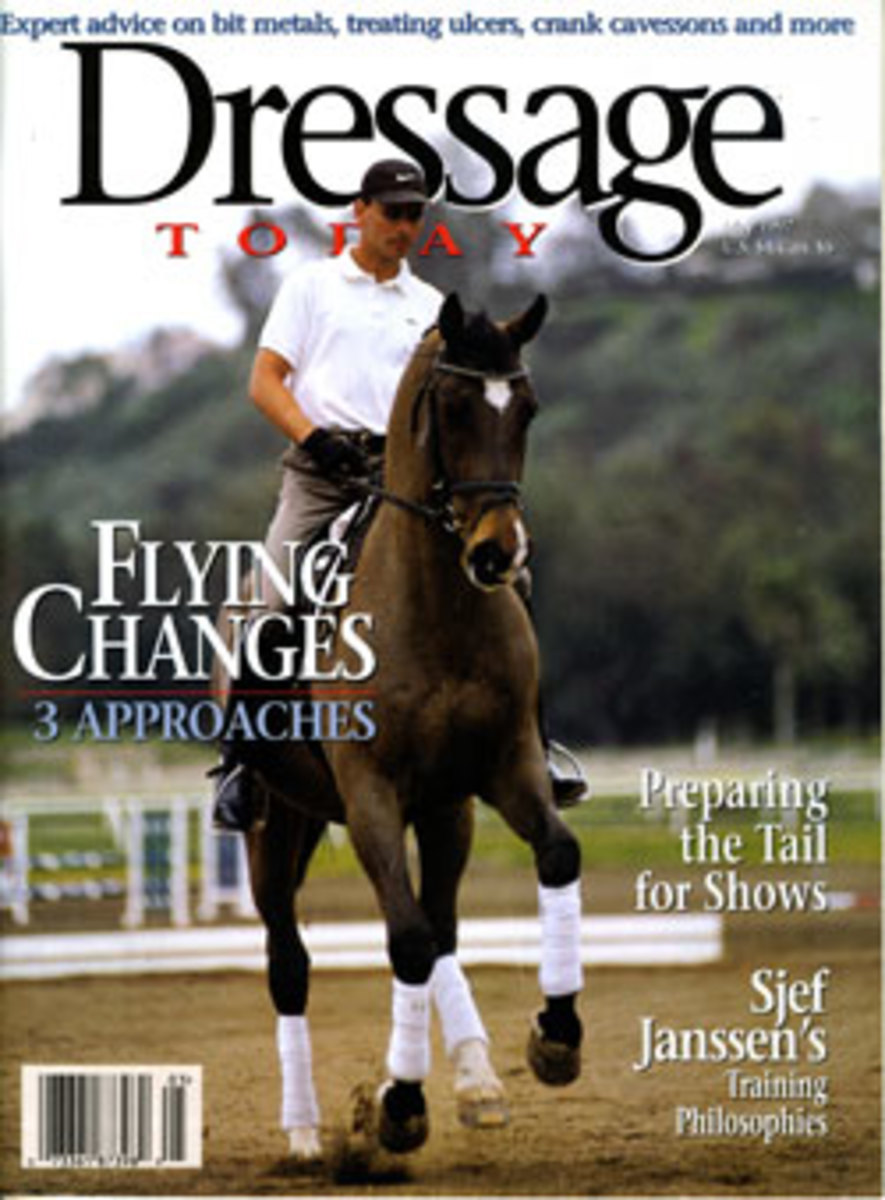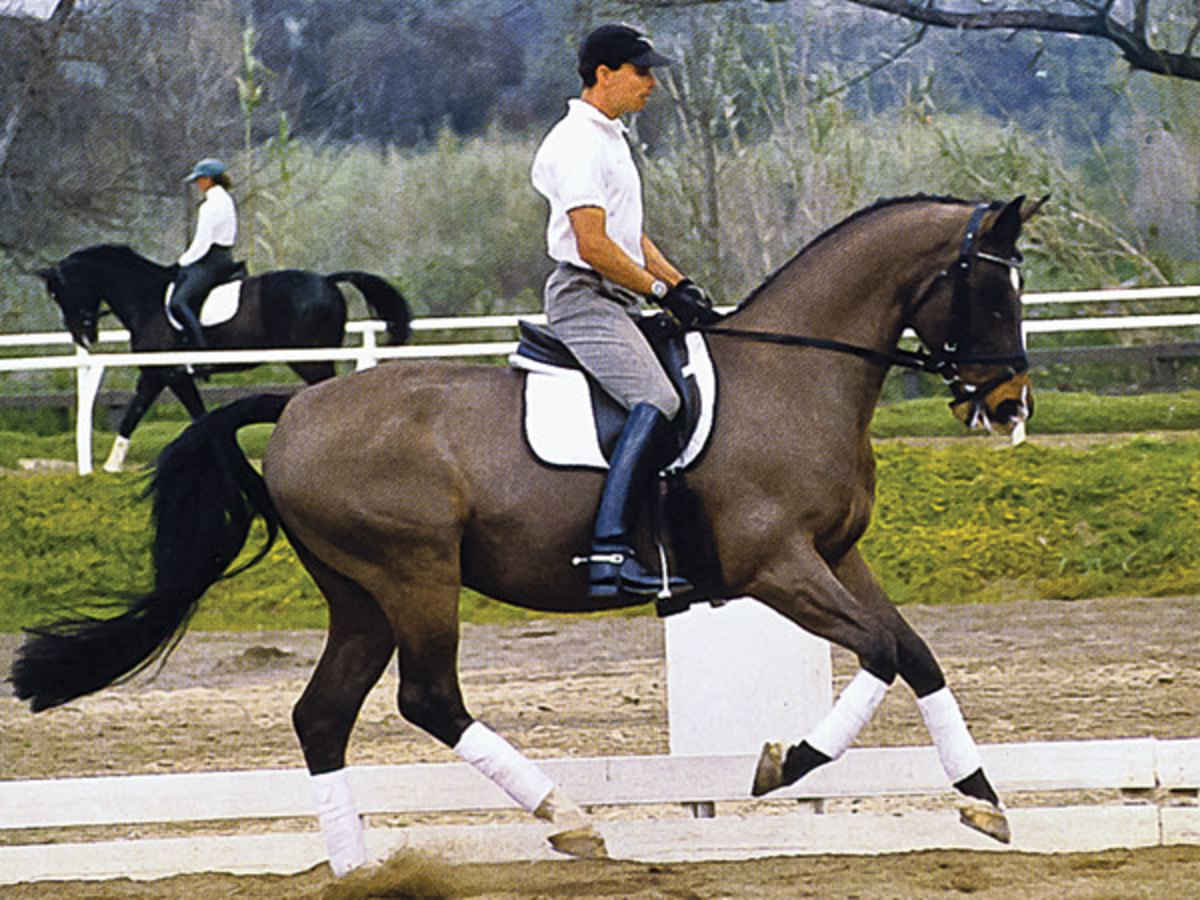
This article was first published in the May 1997 issue of Dressage Today. Lorraine Stubbs was a member of the 1972 and ’76 Canadian Olympic dressage team and also represented Canada in two Pan-American Games. The advice she presents here on how to train the flying changes, from Olympian Steffen Peters and FEI “O: dressage judges Dr. Volker Moritz and Uwe Mechlem, is just as solid today as it was in ’97.

Every trainer has a favorite way of teaching flying changes—when and where to train them seems to promote the greatest disagreement. However, most trainers do agree that certain prerequisites must exist in the horse before flying changes should be attempted: The horse should be balanced, capable of collection and confirmed in counter canter. First called for in the American Horse Shows Association (now USEF) tests at Third Level—when the horse has been working in collection for about a year—flying changes are indicative of a horse’s throughness.
Following are the personal coaching philosophies of Steffen Peters, Uwe Mechlem and Dr. Volker Moritz, three knowledgeable and experienced riders/coaches—two also happen to be among the world’s highest-ranking judges—whom I interviewed for this topic. California-based Peters rode Udon, Lila Kommerstad’s 17-year-old Dutch Warmblood, in the 1996 Olympic Games in Atlanta. German-born Mechlem has been an FEI “O” dressage judge since 1988. As a rider, he earned the title Bavarian Dressage Champion seven times during his career. Also an FEI “O” judge, Dr. Moritz, an active trainer, has been riding for more than 40 years.
Steffen Peters
For many horses, the flying change can be one of the hardest things to learn. Regardless of the age of the horse, it is important to wait with the training until he is relaxed and trusts the rider. This often can take time to attain, as some horses, like the Thoroughbred, can be difficult to “win over.”
Changes should be introduced early enough in a horse’s career that the training progresses slowly and naturally—without inflicting anxiety. Above all, a deadline should not be set for training the exercise—the horse will tell you when he is ready. It’s not wise to train with the thought, I’ve got to get the changes in two months.
In general though, most horses are ready to begin flying changes when they are balanced in the counter canter and can engage with good impulsion.
To succeed in training changes that have clarity and relaxation, the horse must be supple—especially through the back—able to collect and responsive to the leg aid, without being overly sensitive (that is, he shouldn’t run from the leg).
It is also important that the horse possess a clear, round canter and a confident attitude. He should track straight whether on a diagonal line or a serpentine and be willing to pick up any lead regardless of where he is in the arena. The horse shouldn’t show any inclination to swing his haunches in transitions into or out of the canter or within the canter. If he does, do not introduce the flying changes. I often use shoulder-in to help with straightness, but every horse is different, and we must be careful to use straightening exercises that suit each individual horse.
If the horse has a good canter and a talent for collection, he can start training changes sooner than the horse with a rhythm or balance problem. Some horses respond very naturally to the aids for a change, and, in that case, it is not necessary to go through a procedure to set them up.
The Aids
Keep the aids simple. Use the same aids as you would going from walk to canter: inside leg on the girth, outside leg behind. Your inside leg produces the canter or, in this case, the change of lead. Your outside leg initiates the change and keeps your horse straight. Your outside leg should not be too far back. If it is, you may have problems later with tempi changes because you won’t have enough time to give the aid. The outside rein keeps the connection so that your horse doesn’t become flat or unbalanced as he makes the effort. At the same time, the inside seat bone creates the bend.
As the rider, you must be sure your horse feels free to go forward. If you are fearful that your horse may overreact, remove your spurs and just use your calves for the changes. If your horse gets confused about the aids for the change, go back to doing simple changes.
However, for these to be effective, it is paramount for the horse to be balanced so that you can give with the reins and your horse can make fluid transitions both out of and into the canter. If he gets stuck going into walk or has to use his head and neck in the upward transition, he needs more development before you can even start thinking of the changes.
On the other hand, if your horse can make clear, clean, rhythmical transitions, then simple changes can be a good review of the aids before retrying flying changes. Simple changes also help you to be very precise in your aids.
Problem Solving
The biggest problem I see in flying changes is that horses are often late behind. Clean changes are usually a question of having the right amount of collection—of having the horse engaged.
In order to get a high degree of collection, I suggest “schooling pirouttes”: Ride a circle with haunches-in and spiral into a large pirouette. The size of the pirouette depends on your horse’s ability. The emphasis here is on rhythm. Keep his inner hind leg carrying and stepping.
This exercise also helps control the outside hind. Half passes also can help gain control of the outside hind, but it can be a mistake to do changes at the end. You don’t want your horse anticipating a change every time he makes a half pass.
When a horse is late behind, it is not always that the horse is being unresponsive to the rider’s leg; sometimes it is a question of the horse’s coordination. When this happens, keep the horse straight—don’t switch the flexion in the neck. It’s a common mistake for riders to change the neck bend, but in doing this, they restrict the “new” inside hind leg.
Another problem is anticipation. Once the horse understands about flying changes, he might offer one before the aids are given. When this happens, work with the horse in counter canter to get his mind off changes.
Expression in changes comes later. During the introduction, stay positive and keep the horse’s confidence up.
Uwe Mechlem
I like to start flying changes as soon as possible with the horse and not at any one fixed point. Young horses should not get used to changes as a normal part of their routine.
When they are more balanced, then you can start to teach them to execute changes at a certain spot. For example, change rein on a short diagonal and once you come to the wall, change the flexion and the bend (which changes the horse’s balance), and give the aids (not too strong) and try the change.
The Aids
Before the change, the horse is flexed in the direction of the lead he is on—left lead, left flexion. Make the flexion more obvious than normal with the inside driving leg and the outside opposing leg in correct position. Make sure the horse is absolutely straight before the change, then switch your legs to the position for right lead canter and change the flexion as soon as the horse starts the new stride. The leg aids should not be too obvious but the outside leg is used stronger than the inside.
I prefer the long side of the arena for teaching changes because here I can avoid the horse “escaping”—getting crooked—with his hind legs. Also, a straight line helps him to learn to jump forward in his changes. Some trainers prefer to use two circles—the change occurring at the tangent of the two circles. I don’t agree with this because I don’t have as much control of the hind legs as I do against the wall, and the horse can get in the habit of swinging his hindquarters. Never try to ask for the change when the horse is tense or excited. A change must be something normal in a horse’s daily training—nothing special or different or something to fear.
In order to teach the horse the uphill tendency of the change, the rider’s inside hip and outside leg should work together. Multiple changes should not be started before the single change is absolutely confirmed to the extent that the horse’s balance remains the same during the preparation, throughout the change and afterward. The rider needs to use the outside rein with half halts in the same rhythm as the change to keep the horse from falling on his forehand. Impulsion must be maintained during the change. If the horse makes short changes, the rider must think of extending the gait—going more forward—making them out of medium canter.
Problem Solving
If the horse is late behind, he is not correctly balanced and the canter is not elastic: The hindquarters must be more engaged and carry more weight. If he’s on the forehand, the collection is lacking: Use more half halts before the change to improve your horse’s self-carriage. If the horse’s hindquarters are swinging in the changes, the rider’s outside leg aids are too strong and he is changing the flexion too quickly. The horse who does the changes with a high croup is tense in the back or resistant to the rider’s leg. Suppleness must be improved before resuming training the changes.
Volker Moritz
I have been successful in training flying changes by using the counter canter on the long side of the ring or on the diagonal. Sometimes, this method is easier on the horse, and the rider has fewer problems getting the change because of the horse’s natural tendency to want to change back to true canter. Two things are accomplished with this method—counter canter and flying changes—but at the same time.
For me, the counter canter is the first step in the education of teaching changes. If you have a horse who offers changes on his own in the beginning, don’t punish him for it. You have a talented horse and you just have to teach him to wait for your aids—he’s already figured out the changes.
Flying changes are important in all FEI tests and impulsion is very important to changes. The more freedom, the more ground covering, the more expression—the higher the mark. If they are always late behind or crooked, the mark for the change is very low. But also the submission mark in “General Impressions” will be a five or less.
Every horse can do changes—whether they are of high quality is the big question. If a horse reaches eight years of age and is not doing changes, there is concern regarding his general talent and the nature of his training.











